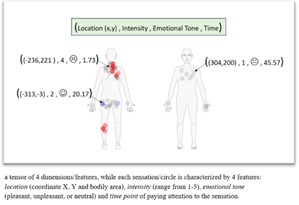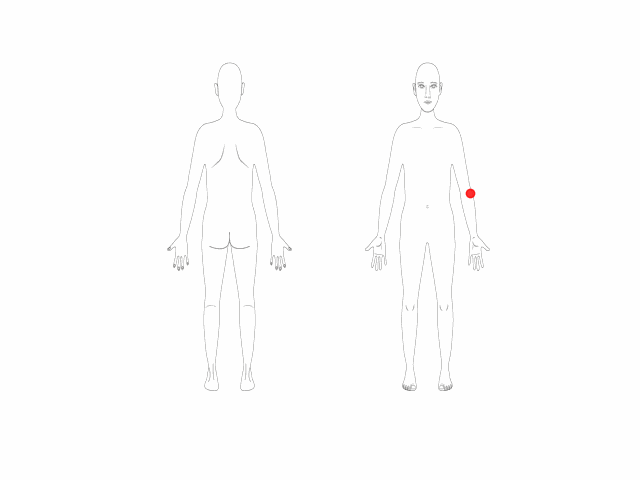How Does Mindfulness Change Awareness of Bodily Sensations?
Omer Dar# - Social Welfare and Health Sciences
Amit Bernstein - Department of Psychology
Pavel Goldstein - School of Public Health
Artificial Intelligence
Health
PhD Grant 2021

 “Scientists have been able to prove that meditation and rigorous mindfulness training can lower cortisol levels and blood pressure, increase immune response and possibly even affect gene expression.” (The Mindful Revolution, TIME). One of the essential mechanisms of action of mindfulness meditation in Buddhist texts and contemporary scientific theory, is cultivating awareness of bodily sensations, but the empirical findings are mixed. An exciting development in the study of mindfulness and attention has focused on internal attention to bodily sensations, referred to as interoceptive attention or body awareness. A promising area of this literature involves measurement of interoceptive attention using a Bodily Sensation Map, wherein participants report subjective bodily sensations and their related features (e.g., location, intensity, emotional tone). Despite the promise of this body map methodology, advances have been limited by aggregated quantification of interoception from, what are in fact complex, multi-dimensional, temporal data. Furthermore, interoceptive attention is inextricably linked to other embodied experiences including thought and emotion, but their inter-relations have yet to be explored in the context of mindfulness.
“Scientists have been able to prove that meditation and rigorous mindfulness training can lower cortisol levels and blood pressure, increase immune response and possibly even affect gene expression.” (The Mindful Revolution, TIME). One of the essential mechanisms of action of mindfulness meditation in Buddhist texts and contemporary scientific theory, is cultivating awareness of bodily sensations, but the empirical findings are mixed. An exciting development in the study of mindfulness and attention has focused on internal attention to bodily sensations, referred to as interoceptive attention or body awareness. A promising area of this literature involves measurement of interoceptive attention using a Bodily Sensation Map, wherein participants report subjective bodily sensations and their related features (e.g., location, intensity, emotional tone). Despite the promise of this body map methodology, advances have been limited by aggregated quantification of interoception from, what are in fact complex, multi-dimensional, temporal data. Furthermore, interoceptive attention is inextricably linked to other embodied experiences including thought and emotion, but their inter-relations have yet to be explored in the context of mindfulness.
As part of the largest study to-date of intensive mindfulness meditation training (N = 147), we measured interoceptive attention using a novel Body Sensations Map technology before and after an intensive week-long mindfulness retreat, relative to a matched controls (study pre-registration: www.clinicaltrials.gov, NCT #04749264). Before and after the retreat (and parallel period among controls), participants were asked to mark the bodily location, intensity, and emotional tone (pleasant/unpleasant/neutral) of each noted bodily sensation, on 2-sided human figures; as well as report their subjective emotional states in response, first, to hearing their own-voice recordings of their neutral simulated thought, and then again, to their negative simulated thought.
In order to discover the impact of mindfulness training on different features of interoception (e.g., detection, differentiation, biases), we are now working to apply data science tools to model the multi-dimensional and spatial-temporal dynamics of interoceptive attention. We hope to advance understanding of interoceptive attention and thereby rigorously test whether and how intensive mindfulness training indeed impacts interoceptive attention. The approach and findings may also have novel implications for basic and clinical science of embodied experience, interoception, and its role in physical and mental health.
Omer Dar, MA, PhD student, School of Psychological Sciences, University of Haifa.
Amit Bernstein, PhD, Director, Observing Minds Lab & The Moments of Refuge Project, School of Psychological Sciences, University of Haifa.
Pavel Goldstein, PhD, Head of Biostatistics Master track and Director of Integrative Pain lab.


“Scientists have been able to prove that meditation and rigorous mindfulness training can lower cortisol levels and blood pressure, increase immune response and possibly even affect gene expression.” (The Mindful Revolution, TIME). One of the essential mechanisms of action of mindfulness meditation in Buddhist texts and contemporary scientific theory, is cultivating awareness of bodily sensations, but the empirical findings are mixed. An exciting development in the study of mindfulness and attention has focused on internal attention to bodily sensations, referred to as interoceptive attention or body awareness. A promising area of this literature involves measurement of interoceptive attention using a Bodily Sensation Map, wherein participants report subjective bodily sensations and their related features (e.g., location, intensity, emotional tone). Despite the promise of this body map methodology, advances have been limited by aggregated quantification of interoception from, what are in fact complex, multi-dimensional, temporal data. Furthermore, interoceptive attention is inextricably linked to other embodied experiences including thought and emotion, but their inter-relations have yet to be explored in the context of mindfulness.
As part of the largest study to-date of intensive mindfulness meditation training (N = 147), we measured interoceptive attention using a novel Body Sensations Map technology before and after an intensive week-long mindfulness retreat, relative to a matched controls (study pre-registration: www.clinicaltrials.gov, NCT #04749264). Before and after the retreat (and parallel period among controls), participants were asked to mark the bodily location, intensity, and emotional tone (pleasant/unpleasant/neutral) of each noted bodily sensation, on 2-sided human figures; as well as report their subjective emotional states in response, first, to hearing their own-voice recordings of their neutral simulated thought, and then again, to their negative simulated thought.
In order to discover the impact of mindfulness training on different features of interoception (e.g., detection, differentiation, biases), we are now working to apply data science tools to model the multi-dimensional and spatial-temporal dynamics of interoceptive attention. We hope to advance understanding of interoceptive attention and thereby rigorously test whether and how intensive mindfulness training indeed impacts interoceptive attention. The approach and findings may also have novel implications for basic and clinical science of embodied experience, interoception, and its role in physical and mental health.
Omer Dar, MA, PhD student, School of Psychological Sciences, University of Haifa.
Amit Bernstein, PhD, Director, Observing Minds Lab & The Moments of Refuge Project, School of Psychological Sciences, University of Haifa.
Pavel Goldstein, PhD, Head of Biostatistics Master track and Director of Integrative Pain lab.

